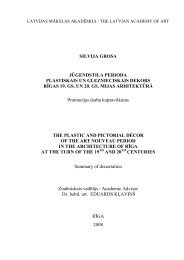Institute of Art History of the Latvian Academy of Art Anna Ancāne ...
Institute of Art History of the Latvian Academy of Art Anna Ancāne ...
Institute of Art History of the Latvian Academy of Art Anna Ancāne ...
Create successful ePaper yourself
Turn your PDF publications into a flip-book with our unique Google optimized e-Paper software.
Ne<strong>the</strong>rlands in <strong>the</strong> 1660s possibly was decisive in <strong>the</strong> formation <strong>of</strong><br />
Palladian architecture in Riga.<br />
Stockholm, Revel, Narva and Pärnu<br />
In <strong>the</strong> 2 nd half <strong>of</strong> <strong>the</strong> 17 th century Stockholm was <strong>the</strong> leading centre<br />
dictating <strong>the</strong> region’s political and economic scenario and influencing<br />
also <strong>the</strong> building culture <strong>of</strong> provincial towns. Swedish contemporary<br />
architecture was inspired by French and Italian examples as well as<br />
classical trends <strong>of</strong> <strong>the</strong> University <strong>of</strong> Leyden. Defining Riga’s architectural<br />
tendencies in <strong>the</strong> late 17 th century, <strong>the</strong>y cannot be typified as a mix <strong>of</strong><br />
influences identical to Stockholm; <strong>the</strong> style <strong>of</strong> Swedish nobility was just a<br />
part <strong>of</strong> <strong>the</strong> overall scene <strong>of</strong> Riga’s Baroque architecture. “Swedish”<br />
palaces with a mansard ro<strong>of</strong> or palazzo-type buildings were constructed<br />
for <strong>the</strong> Swedish <strong>of</strong>ficials residing in Riga and importing <strong>the</strong> Stockholm<br />
building types, but <strong>the</strong> local patricians were more oriented towards <strong>the</strong><br />
examples <strong>of</strong> Nor<strong>the</strong>rn Germany and <strong>the</strong> Ne<strong>the</strong>rlands. Thus one cannot<br />
agree with <strong>the</strong> view <strong>of</strong> classical influences travelling to Sweden via<br />
Nor<strong>the</strong>rn German towns, and <strong>the</strong>n disseminating in <strong>the</strong> Swedishcontrolled<br />
territories. The real scene <strong>of</strong> influence routes was much more<br />
complex.<br />
It is important to compare Riga’s Palladianism with o<strong>the</strong>r Eastern Baltic<br />
cities – for example, Revel and Narva. In <strong>the</strong> 1680s and 1690s classical<br />
trends took on strength in Riga, still <strong>the</strong> question as to which moment was<br />
decisive in this direction remains open. In Estonia <strong>the</strong> first city dwellings<br />
based on classical orders appeared in <strong>the</strong> 1660s, taking over fresh<br />
examples from Stockholm. If <strong>the</strong> Swedish-type Classicism is typical for<br />
Revel (Axel von Rosen’s House), in Riga <strong>the</strong> Flemish-Dutch attitudes<br />
and treatment <strong>of</strong> décor is sensed. In Revel Classicist ideas had little<br />
influence over average buildings. In Riga patrician houses complying<br />
with <strong>the</strong> style <strong>of</strong> classicising Baroque appeared later but changes were<br />
more pr<strong>of</strong>ound to affect also <strong>the</strong> rest <strong>of</strong> dwelling house architecture.<br />
Façade surveys <strong>of</strong> Revel also do not feature volute gables – so <strong>the</strong>y are<br />
one <strong>of</strong> <strong>the</strong> specific traits <strong>of</strong> Baroque Riga within <strong>the</strong> geographically close<br />
cultural space. More side-gabled houses are found in Riga in <strong>the</strong> 2 nd half<br />
<strong>of</strong> <strong>the</strong> 17 th century in comparison with Revel. But in Narva one can find<br />
both interpretations <strong>of</strong> classical order close to Riga and pronouncedly<br />
archaic phenomena. A shared feature was <strong>the</strong> combining <strong>of</strong> rich portals<br />
with Palladian facades.<br />
Schleswig-Holstein<br />
Regarding influences, Hamburg was one <strong>of</strong> <strong>the</strong> major centres <strong>of</strong> Palladian<br />
architecture in Nor<strong>the</strong>rn Germany; in <strong>the</strong> 17 th century it has been even<br />
compared to Amsterdam and described as “more Dutch than Central<br />
German town”. The output <strong>of</strong> Hamburg master builders is somewhat<br />
parallel to that <strong>of</strong> Riga’s examples, especially <strong>the</strong> work <strong>of</strong> Johann Jacob<br />
27












